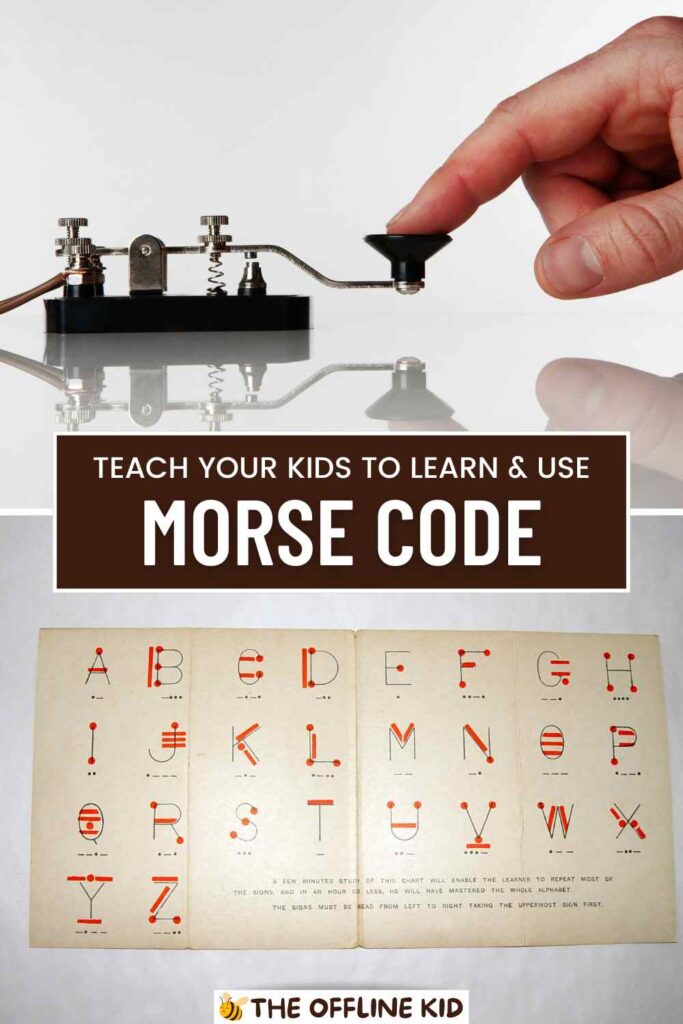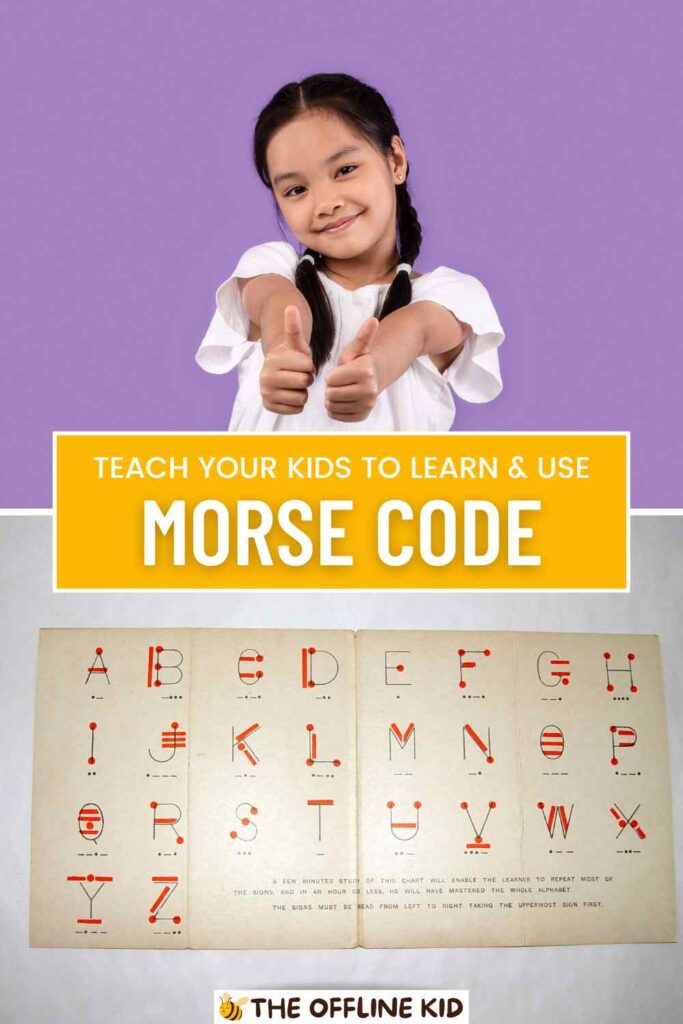Welcome to the ultimate guide for kids to learn Morse code!
Discover the history, basics, fun activities, and projects to become a Morse code pro.
History of Morse Code
The Origin of Morse Code
Morse code was invented by Samuel Morse and Alfred Vail in the early 1830s. Samuel Morse, an artist and inventor, wanted to create a way to send messages over long distances quickly.
Together with Vail, they developed a system of dots and dashes to represent letters and numbers, allowing for the transmission of complex information using simple signals.
Early Uses of Morse Code
- Telegraphy: The first practical use of Morse code was through the telegraph, an early communication device that used electrical signals to transmit messages over wires.
- Railroads: Morse code was vital for coordinating train schedules and ensuring the safety of railway operations.
- Maritime Communication: Ships at sea used Morse code to communicate with each other and with shore stations, especially during emergencies.
Morse Code in History
- SOS Signal: One of the most famous uses of Morse code is the SOS distress signal (··· — ···), introduced in 1905. It quickly became the international standard for requesting emergency assistance.
- World Wars: During both World War I and World War II, Morse code was extensively used for military communications. Soldiers, spies, and resistance fighters relied on Morse code to send and receive critical information.
- Space Exploration: Astronauts have used Morse code to communicate in space missions, including the famous Apollo missions.
Modern Day Uses of Morse Code
- Amateur Radio: Enthusiasts still use Morse code in amateur radio (ham radio) for long-distance communication.
- Aviation and Navigation: Pilots and navigators use Morse code to identify navigational aids and beacons.
- Emergency Situations: Morse code remains a reliable means of communication when other methods fail, such as in disaster scenarios or power outages.
Morse code has a rich history, evolving from a groundbreaking 19th-century invention to a versatile tool still used in various fields today.
Understanding its origins and historical significance adds depth to the learning experience, making it more engaging and meaningful for kids.
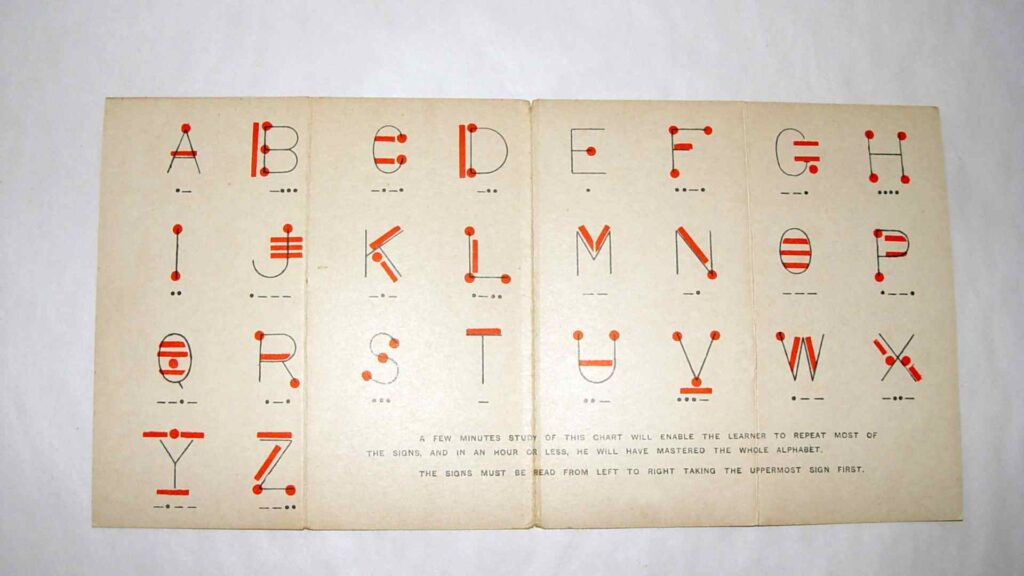
The Basics of Morse Code
Understanding the Alphabet and Numbers
Morse code uses combinations of dots and dashes to represent letters, numbers, and punctuation. Here’s how each letter and number is represented:
- Letters:
- A (·-), B (-···), C (-·-·), D (-··), E (·), F (··-·), G (–·), H (····), I (··), J (·—), K (-·-), L (·-··), M (–), N (-·), O (—), P (·–·), Q (–·-), R (·-·), S (···), T (-), U (··-), V (···-), W (·–), X (-··-), Y (-·–), Z (–··)
- Numbers:
- 0 (—–), 1 (·—-), 2 (··—), 3 (···–), 4 (····-), 5 (·····), 6 (-····), 7 (–···), 8 (—··), 9 (—-·), 10 (·—- —-·)
- Punctuation:
- Comma (–··–), Period (·-·-·-), Question Mark (··–··), Exclamation Mark (··–··–), Colon (—···), Semi-Colon (-·-·-), Apostrophe (·—-·), Quotation Marks (·-··-·), Hyphen (-····-), Slash (-··-·), Parentheses (-·–·-), Ampersand (·-···), Equals Sign (-···-), Plus Sign (·-·-·), Dollar Sign (···-··-), At Sign (·–·-·)
Dots and Dashes
- Dot (·): Represents a short signal.
- Dash (-): Represents a longer signal.
- Timing: The duration of dots and dashes is crucial for decoding Morse code accurately.
Learning the Rhythm
- Rules: Morse code follows specific timing rules. For example, the letter A (·-) is one dot followed by one dash, with a short pause between elements.
- Practice: Begin with simpler letters and numbers and progress to more complex combinations. Practicing the rhythm helps develop fluency in Morse code decoding and encoding.
Understanding the unique representations for each letter, number, and punctuation mark in Morse code is essential for mastering this communication method effectively.
Tools for Learning Morse Code
Traditional Tools
- Flashcards: Create flashcards with Morse code symbols on one side and corresponding letters or numbers on the other. Use them for quick practice sessions.
- Paper and Pencil: Write out Morse code messages by hand to reinforce learning through visual and motor memory.
Digital Tools
- Apps and Websites: Explore interactive apps and websites that offer Morse code lessons, quizzes, and games. Examples include Morse Mentor, Morse Toad, and CW Academy.
- Online Games: Engage in online games that incorporate Morse code, such as Morse Runner or Ham Radio Deluxe, to practice in a fun and competitive environment.
Physical Tools
- Morse Code Keys: Use a Morse code key (telegraph key) to manually create dots and dashes. This hands-on approach enhances tactile learning and reinforces the rhythm of Morse code.
- Lights and Sound Devices: Experiment with devices that emit light or sound signals corresponding to Morse code symbols. These tools provide immediate feedback and reinforce auditory learning.
By utilizing a variety of traditional, digital, and physical tools, kids can explore Morse code through different sensory experiences, enhancing their understanding and proficiency in this communication method.

Fun Ways to Learn Morse Code
Interactive Games
- DIY Morse Code Games: Create your own Morse code decoding and encoding games using household items like flashlights, buttons, or even tapping rhythms.
- Online Morse Code Games: Explore interactive websites and apps that gamify Morse code learning with challenges and rewards.
Crafting Morse Code Messages
- Morse Code Bracelets or Necklaces: Make bracelets or necklaces using beads or knots to represent dots and dashes. Kids can wear their creations and decode secret messages.
- Writing with Invisible Ink: Use lemon juice or other invisible inks to write Morse code messages that become visible when heated or treated.
Team Activities
- Group Decoding Challenges: Organize decoding challenges where teams compete to decipher Morse code messages the fastest.
- Morse Code Scavenger Hunts: Create scavenger hunts where clues are written in Morse code, leading to hidden treasures or rewards.
Engaging in these creative and interactive activities not only makes learning Morse code enjoyable but also reinforces understanding through practical application and teamwork.
Step-by-Step Guide to Learning Morse Code
Learn the Alphabet and Numbers
- Focus on One Character at a Time: Begin with letters A-Z and numbers 0-9. Practice recognizing each Morse code symbol and its corresponding character.
- Use Flashcards or Apps: Flashcards can help with quick recognition, while apps provide interactive learning experiences.
Practice Common Words and Phrases
- Start with Basic Words: Begin with simple words like SOS, HELP, YES, and NO. Practice writing and decoding these common phrases.
- Expand to Simple Sentences: Once comfortable with individual words, progress to decoding and encoding simple sentences using Morse code.
Build Your Skills
- Consistent Practice: Regular practice is key to mastering Morse code. Dedicate short sessions daily to reinforce learning and improve fluency.
- Utilize Different Learning Tools: Experiment with traditional tools like paper and pencil, as well as digital tools such as Morse code apps or online games.
Test Your Knowledge
- Take Quizzes and Challenges: Test understanding with quizzes that require decoding Morse code messages. Challenge yourself with timed exercises to improve speed and accuracy.
- Compete in Fun Challenges: Engage in friendly competitions with friends or family members to see who can decode messages the quickest.
By following these steps and incorporating regular practice and fun challenges, kids can gradually build their Morse code skills and confidently send and receive messages using this fascinating communication method.
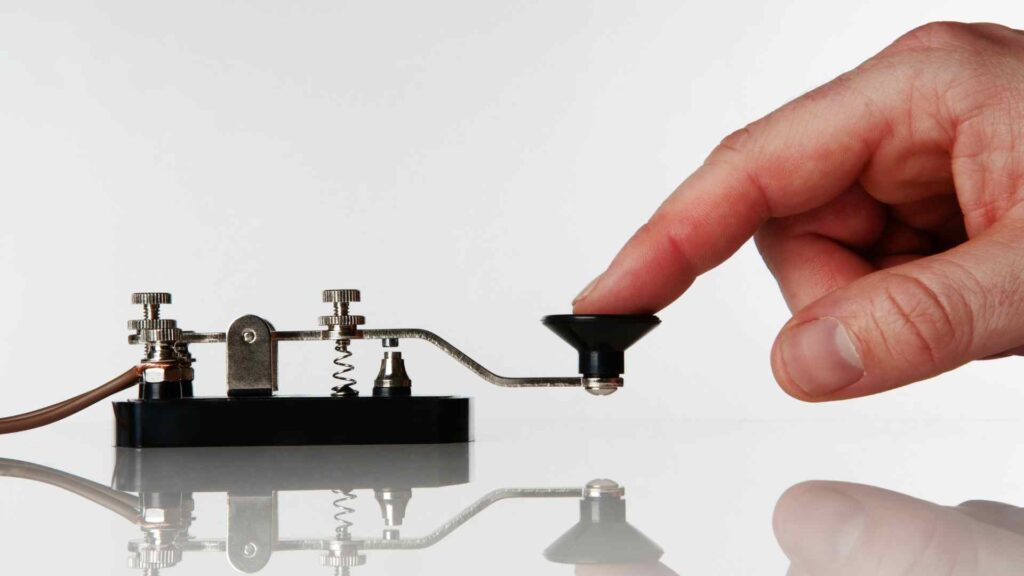
Sending Messages with Morse Code
Writing Messages
- Encoding Messages: Use the Morse code alphabet to write messages. Each letter, number, and punctuation mark corresponds to a specific combination of dots and dashes.
- Practice Writing: Start with simple messages and gradually increase complexity as proficiency improves.
Sending Messages
- Using Light Signals: Use a flashlight or other light source to transmit Morse code signals. Short flashes represent dots, and longer flashes represent dashes.
- Using Sound Signals: Tap out Morse code on a surface or use a sound-emitting device such as a buzzer or whistle. Short taps or sounds represent dots, and longer taps or sounds represent dashes.
Receiving Messages
- Decoding Messages: Learn to decode Morse code signals received through light or sound. Translate the series of dots and dashes back into letters, numbers, and punctuation.
- Improving Accuracy: Practice decoding messages of increasing complexity to improve accuracy and speed.
Mastering the art of sending and receiving Morse code messages allows kids to communicate effectively in a unique and historical way, fostering creativity and problem-solving skills.
Morse Code Projects and Activities
Build a Morse Code Kit
- Materials Needed: Gather materials such as a flashlight, Morse code chart, and paper.
- Instructions: Create a portable Morse code kit with instructions on how to use it.
- Activity: Practice sending and decoding messages with the kit.
Create a Morse Code Journal
- Purpose: Keep track of Morse code practice sessions and progress.
- Design: Decorate a journal with Morse code symbols or messages.
- Recording Messages: Write down encoded messages and their translations for future reference.
Morse Code Art
- Concept: Use Morse code to create artistic designs or messages.
- Materials: Gather art supplies like paints, markers, or digital tools.
- Examples: Design posters, greeting cards, or digital artworks using Morse code patterns or messages.
Engaging in these creative Morse code projects not only reinforces learning but also encourages exploration and application of Morse code skills in practical and artistic ways.
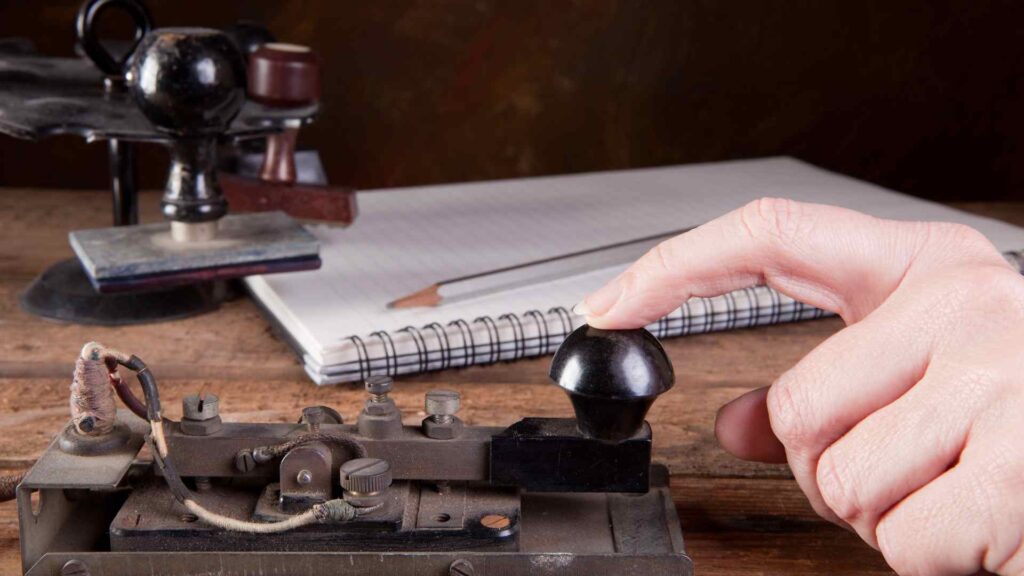
Advanced Morse Code Tips
Speed and Efficiency
- Increasing Speed: Practice regularly to increase your Morse code sending and decoding speed.
- Efficient Communication: Learn abbreviations and shortcuts commonly used in Morse code to transmit information more quickly.
Morse Code Competitions
- Participating in Contests: Join Morse code contests or challenges organized by amateur radio clubs or online communities.
- Setting Goals: Set personal goals for speed and accuracy to improve performance in competitions.
Practical Applications
- Emergency Communication: Understand the role of Morse code in emergency situations where other forms of communication may be unavailable.
- Exploration and Discovery: Explore how Morse code is used in various fields such as amateur radio, aviation, and maritime communication.
Advanced Techniques
- Prosigns and Procedural Signals: Learn prosigns (combination of letters representing a single procedural signal) used to convey specific meanings in Morse code.
- Interpreting Non-Verbal Cues: Develop the ability to interpret nuances in Morse code signals that convey urgency, emphasis, or context.
Mastering these advanced Morse code techniques enhances proficiency and opens up opportunities for practical use and exploration in various contexts.
Conclusion
Congratulations on completing the ultimate guide to learning Morse code and sending messages! Throughout this journey, you’ve explored the history, mastered the basics, engaged in fun activities, and honed your skills in Morse code communication.
Remember, Morse code is more than just dots and dashes—it’s a gateway to creativity, problem-solving, and historical exploration. Keep practicing, experimenting, and discovering new ways to use Morse code in your everyday life.
Whether you’re sending secret messages with friends or participating in Morse code competitions, the skills you’ve developed will continue to serve you well. Embrace the adventure of Morse code, and let its timeless language inspire your curiosity and communication skills!
